· 16 min read
How I Organize My Trello for Maximum Personal Productivity
A Look at Board Structure, Card Structure and Dashboard Board that Help Me Stay Organized
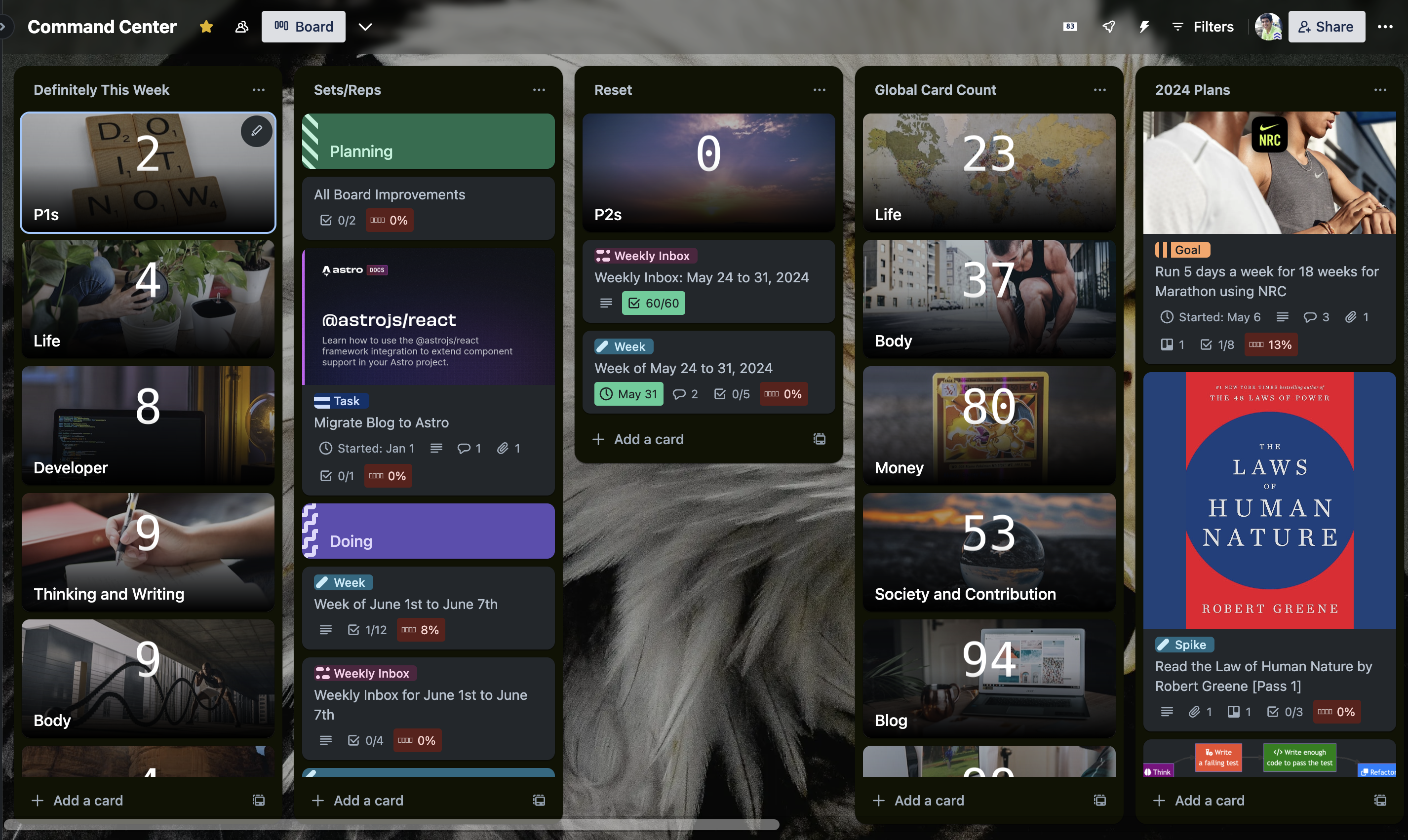
Trello is a simple Kanban tool I use to organize my life. It helps me:
- Clarity: gain clarity of what I want to do and how to do it
- Responsibility: help me do it to the best quality I can produce
- Optimism: Help me be happy and less stressed, avoid burnout, and maintain a history of things I have done.
- Flow: get out of my way so that I can live life (🔗 TODO: Link to Flow Blogpost)
I think of Trello as an efficient production line that can help organize almost anything and get it done step by step. I use it for nearly everything, from blogpost production to travel inventory, goals, learning, and tracking psychological/inner child work.
If you are new to Trello, I recommend you watch a video and create a simple Trello board before reading this post.
In this post, you’ll learn how you can use trello efficiently.
- Board Structure
- Card Structure
- Command Center / Dashboard Board
I’ll also share:
- Tips on Creating & Managing Multiple Boards Without Getting Overwhelmed
- How to Keep Board Interesting to Use
You don’t need to implement everything I suggest.
- keep things simple and scale if you need
- When you don’t need to scale down the system, make it simpler.
- aim for achieving balance.
My system is every evolving. You can assume that my current system is an evolved version of the one below.
Optimizing Trello for Maximum Productivity
Trello/Kanban can scale to our needs. If you are getting started, a simple setup may be enough. But as time passes and you get more productive, you’ll find you need to [optimize your system for scale] (🔗 TODO: Link To Post), or else the system starts choking.
Here are a few things I’ve done to optimize my Trello setup:
- Board Structure: A well-organized board helps me focus on what needs to be done now and ensures I complete tasks fully.
- Card Structure: Capturing all necessary information in the card helps me execute tasks to the best of my ability.
- Dashboard Board: This board overviews all tasks across multiple boards, helping me prioritize what’s important.
By following these steps and continuously refining your system, you’ll be able to maintain high productivity and stay organized.
Board
Board Structure
A good board structure aims to help you be extremely organized and help you decide what to do next.
The basic Trello structure includes the following columns:
- To Do
- Doing
- Done
Image: Typical Trello Board Structure when starting out.
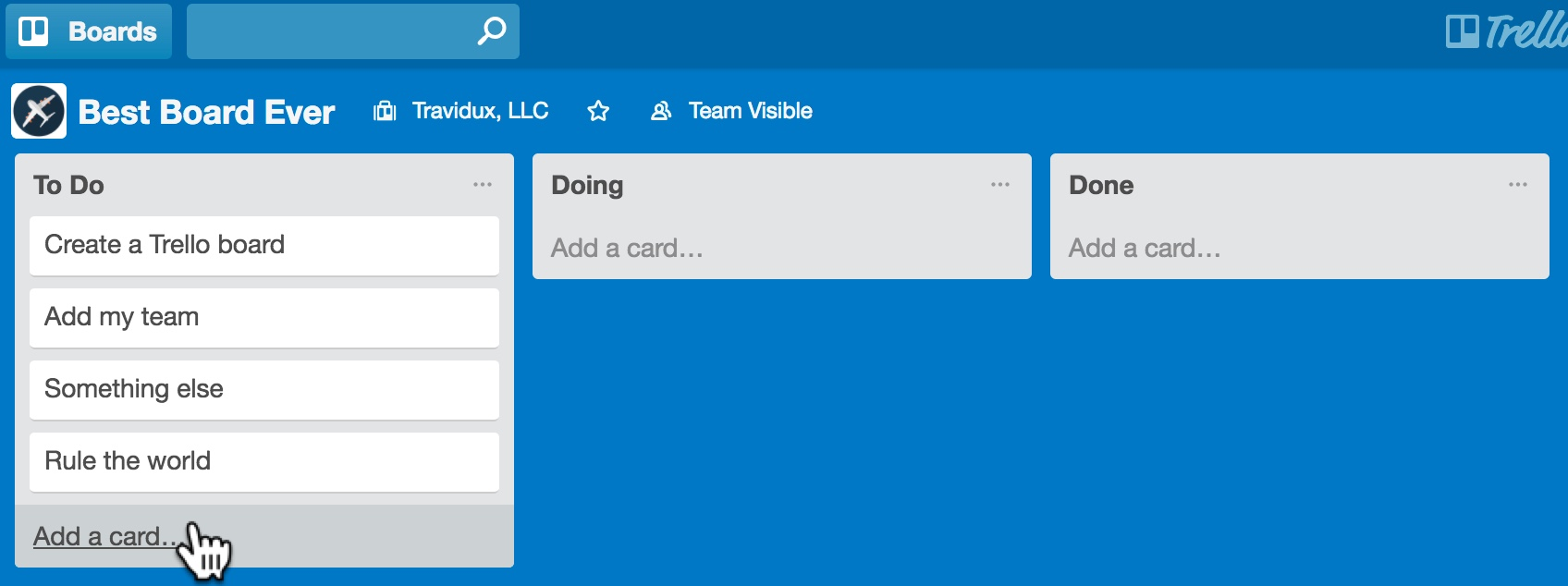
I enhance the column by splitting it into multiple columns. But I only do this when the number of cards increases. If the number of cards is less, I’ll again switch back to a number of columns.
Enhancing the “To Do” Column
Instead of having a single “To Do” column, consider splitting it into multiple columns to prioritize tasks better:
- This Week: Tasks you aim to complete this week. Initially, this column can help focus your efforts. As you refine your system, you may rely on it less.
- Future Planning Columns: Use multiple columns to prioritize upcoming tasks. This helps keep your current focus clear and your future tasks organized.
I organize my Trello board with the left section focused on current tasks and the right section for future planning and knowledge units. Here’s a breakdown of how I manage future planning columns based on different domains:
Example: Blogging Board
- Needs Organization: Ideas that need to be sorted and structured.
- Needs Refinement: Developed ideas that require further refinement.
- Ready for Production: Fully developed ideas ready to be executed.
When it’s time to write a blog post, I pick a task from the “Ready for Production” column.
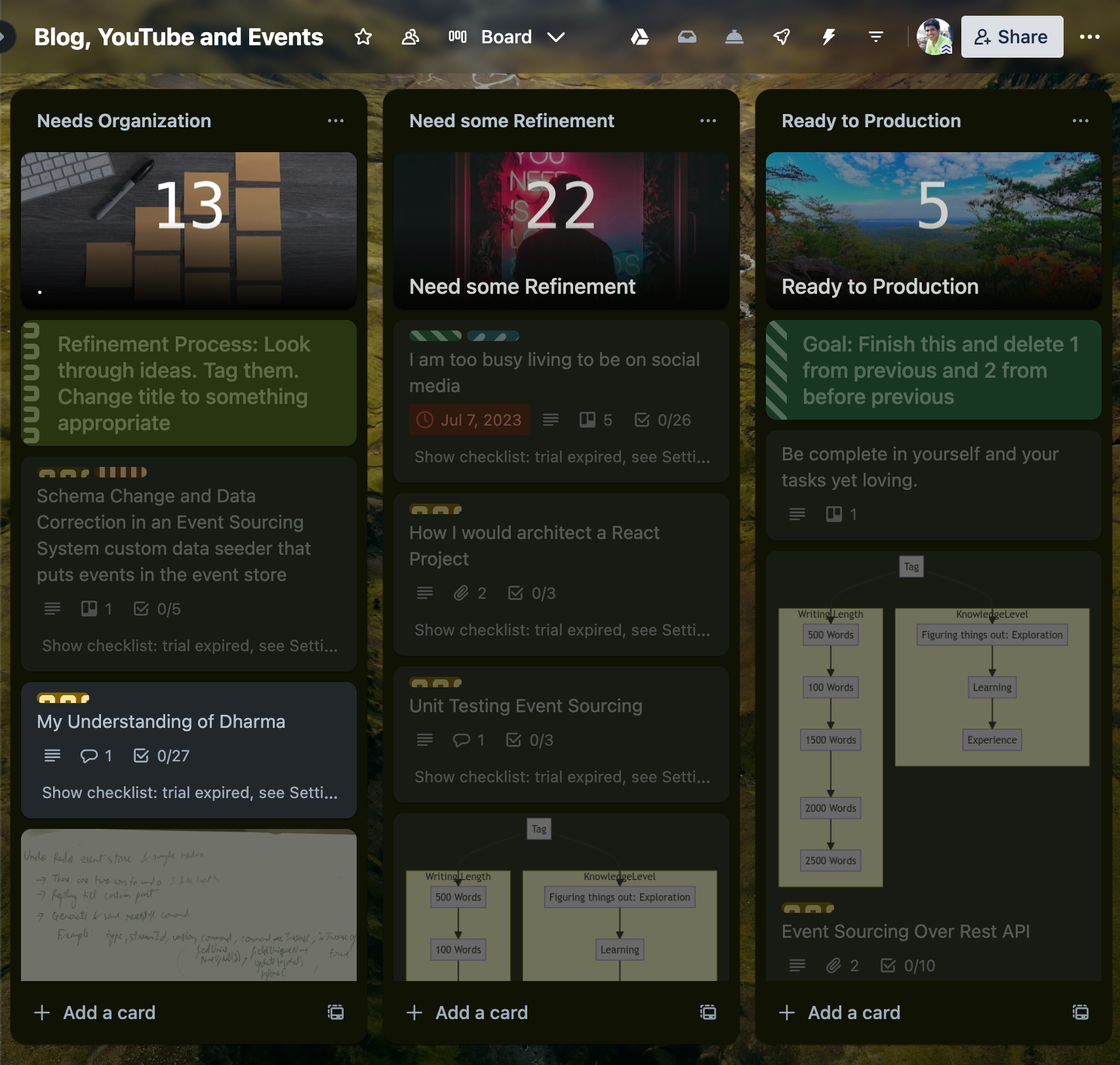
Example: Travel Board
My goal is to travel to India and start my world tour in the next few years. Also, there are some that are not travel-related.
So broadly, I have these sets:
- Non-Travel
- World Tour: Columns for planning an international trip.
- India: Columns for domestic travel plans.
World Tour
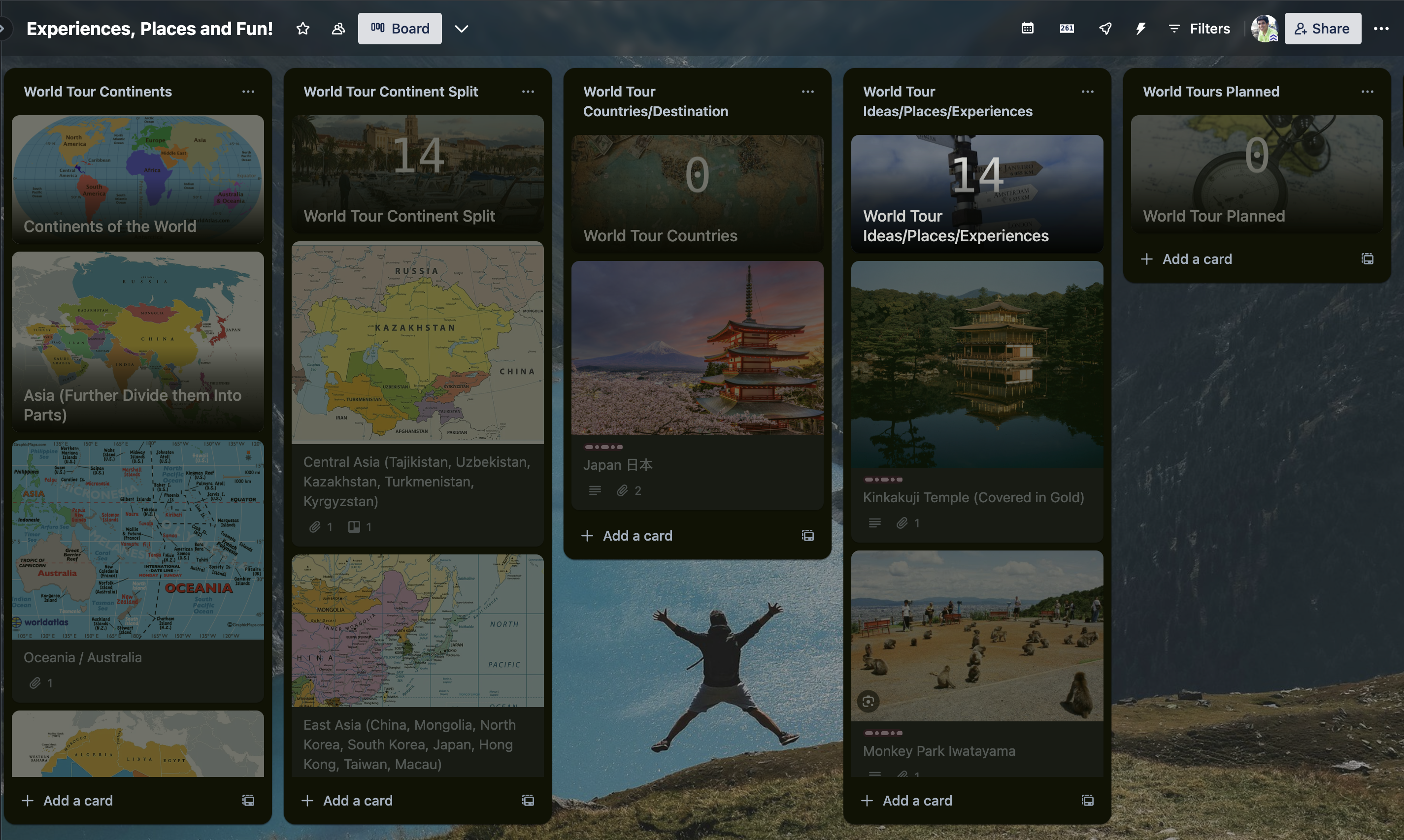
Bharat
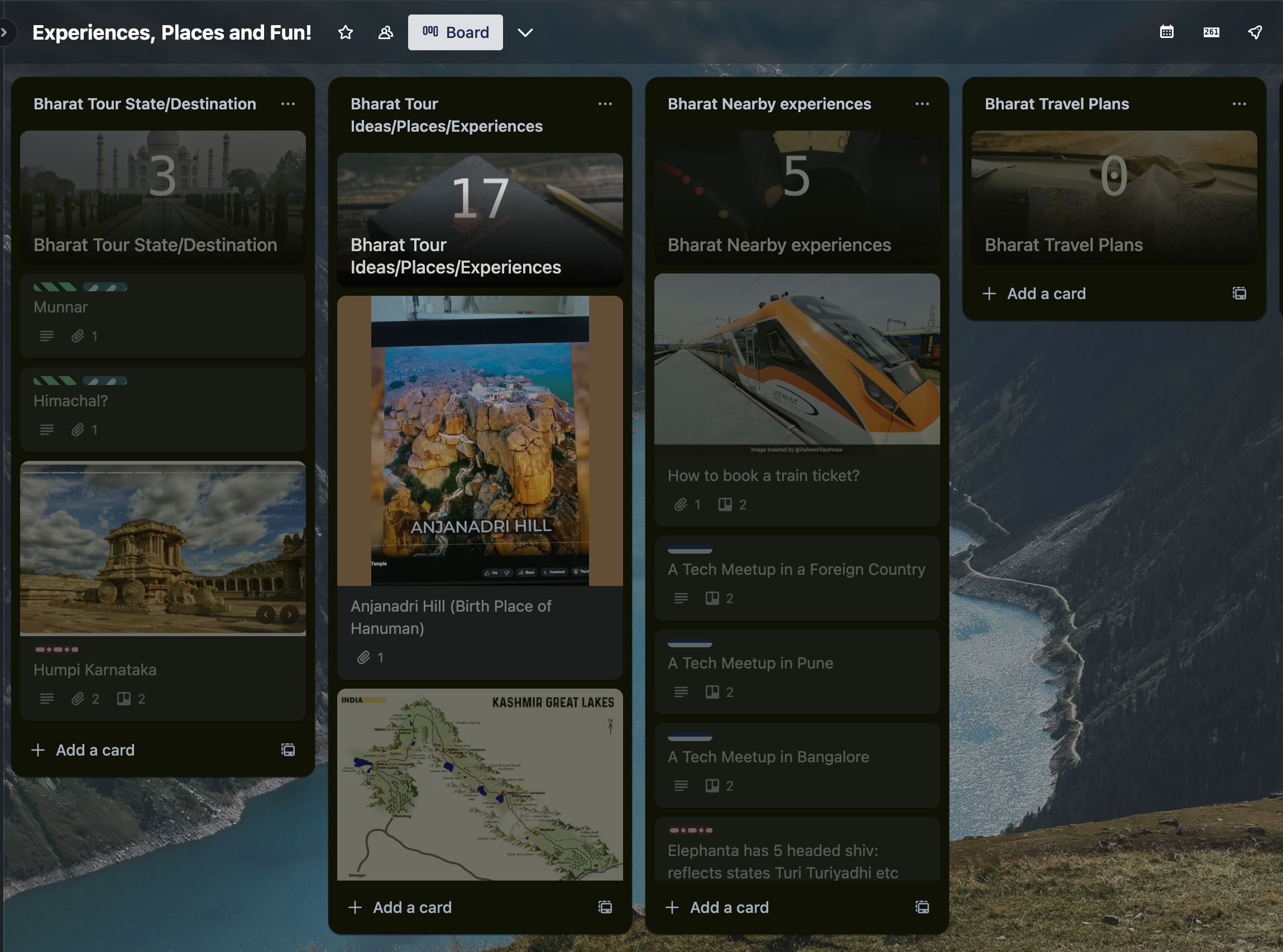
Tip: Using the MoSCoW Method
If you’re unsure how to categorize tasks in a new domain, try the MoSCoW method:
- Must Do: Essential tasks that need immediate attention.
- Should Do: Important tasks that should be done but are not critical.
- Can Do: Tasks that are nice to do but not urgent.
- Won’t Do: Tasks that are not necessary or relevant at the moment.
I can prioritize and manage tasks more effectively by customising columns based on the specific domain.
How do I pick tasks?
My philosophy is roughly based on the Eisenhower matrix:
- Urgent & Important Tasks: Given immediate attention, these tasks significantly impact my goals or responsibilities.
- Non-urgent Important Tasks: Despite being non-urgent, these are crucial for long-term success, reducing future emergencies and smaller tasks.

I prioritise non-urgent and important tasks as they eliminate smaller tasks and help me get ahead. Some examples of such tasks are:
- Reading: A book like Design Patterns, which will help me understand all of the software
- Implementing: A new technique/organization tip like this Trello system, which helped me stay highly organized
- Setting up my financial flywheel: I can have enough money to do what’s meaningful.
- Psychological work: That helped me be less stressed and improve my day-to-day well-being.
- Communication skills So that I can have clear thoughts, happier times with people and better opportunities.
Doing these tasks properly frees up more time in the future.
Example: Self-Help Videos
- I used to have many self-help video cards on social skills and communication. I deleted many of them post-therapy, freeing up time and mental RAM.
- Similarly, after studying the Bhagavad Gita, I deleted about 40 related tasks, streamlining my workload.
Essentially, you want to solve the root of the problem. Once solved fully, it’ll eliminate all the other issues.
Enhancing the “Doing” Column
A single doing column doesn’t indicate how much you have progressed on a task. It’s better to have multiple columns.
Initially, I used percentage completions (10% complete, 50% complete, …), but it was challenging to measure progress accurately. It’s better to have a named stage.
As with the “To Do” columns split, it’s better to develop it by domain.
Example: Blogging Board
- Clarity
- Writing / Recording
- Self Proof Reading, Refinement and Review
- SEO / Promotion / Content Marketing
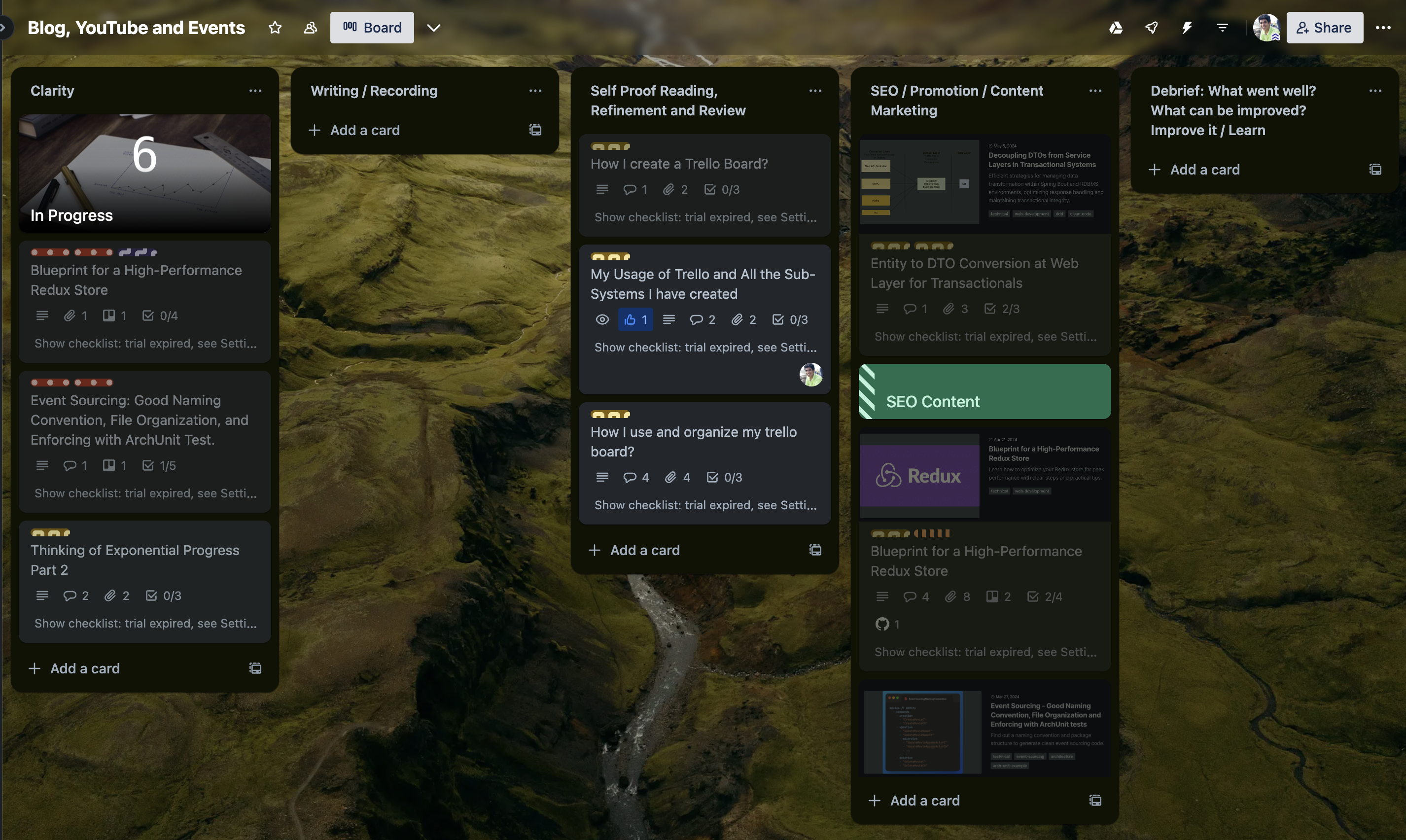
Like with MosCow, my default for most boards is:
- Planning and Research: Tasks start here and involve initial research and planning.
- Learning / Doing: Active work on the task, including learning and execution.
- Feedback and Debrief: Review and gather feedback to refine the task.
Example: Fitness Board
- Planning, Intellectual Learning and Physical Learning
- Repetition and Sets
- Feedback, Recording, and Debrief: What went well? What can be improved? Improve it / Learn
This way, I know exactly what stage each task is in and what needs to be done next.
Enhancing the “Done” Column
Completing a task often isn’t as straightforward as marking it “done.” We want to:
- maximize the outcome we get from a task
- Ensure we complete it fully (nothing is left).
One of Narendra Modi’s characteristics is following through until the end. He would make sure he is monitoring things comprehensively. And that is what we need to do; we have to make sure all tasks are done by the end.
Here are a few columns I have divided “Done” into.
- Debrief
- Chained Tasks
- Frozen / Auto Pilot
- Closed / X Ledger
Debrif Column
The first step in optimizing learning after a task is a quick debrief.
Before Done I have a debrief column where I ask myself:
- What went well? (Written in the comment)
- What can be improved? (Written in the Debrief Tasks Checklist)
This way, I have captured what I learned with the task, which will enhance my future work.
If there are “Debrief Tasks”, I’ll move the card to the “Chained Tasks” Columns.
Chained Tasks
Chained Tasks means: “This task is complete, but other tasks were created because of this task that are yet complete. So we can’t mark this task as fully complete.”
It’s essential to track these chained tasks to ensure nothing remains undone and everything is followed through to the end.
Example: Blogpost
In many of my blog posts, including this one, you’ll see 🔗 TODO written. I have blog post ideas related to the post I am writing. If a post I write has TODOs, I’ll move it to the “Chained Tasks” column. And they’ll stay in Chained Tasks until All other Chained Tasks are Complete.
To manage chained tasks, I use a three-fold system:
- Chained Column on the Board: A dedicated column to track all chained tasks.
- Checklist for Chained Tasks: A checklist within the main task card to list all related subtasks.
- Chained Label: A label to quickly identify and filter chained tasks across the board.
This system ensures that all tasks are completed fully and thoroughly, following through every detail until the end.
Frozen / Delegated
Sometimes,
- tasks are completed but need to be revisited later.
- Or, while doing a task, you realize the problem will auto-fix in a few days.
- Or you have delegated the task to someone else.
For such tasks, I use the “Frozen / Delegated” column. This helps keep track of tasks that are on hold but still need attention.
Closed
This is a simple column that denotes the task is done a task entirely and closed. This means I don’t have to do anything more about this.
The closed column gives me confidence in my productivity. And there, it also has a surname: A Complete Ledger.
Example of Closed Column on different boards
- Life Board: “Closed / Karma Ledger”
- Travel Board: “Closed / Interesting Life Ledger”
- Blogging Board: “Closed / Thought Clarity Ledger”
Naming it this way has been helpful to me. (🔗 TODO: Blogpost on the importance of naming on human behaviour)
Summarizing Enhancing the “Done” Column
You can ensure comprehensive task management and continuous improvement by organizing the “Done” column into specific categories and maintaining a detailed system for chained tasks. And ensure nothing goes out of your mind.
Enhancing Knowledge Capture (Unfinished Idea: 🔗 TODO: Improve this aspect, then write about it)
I need an excellent insight into capturing long-term ideas. For example, if I learn something that I want to access later.
There is some fundamental knowledge about any long-term domain that you would like to be reminded of.
For this, I have added a column with such information.
For example, my “Finance Flyway” board has these columns at the right.
- Monthly Spending: A card per month for monthly spending
- Money Goals: All my financial goals regarding money.
- Money Formulas: Things like 50:30:20. Rule of 72 etc.
- Money Mindset: Repair over Buy. Protect Electronics. Think of Money as Value.
- Trusted Entities: Companies and People I trust
- Bad Entities: Companies and People I can’t trust financially or even personally.
I have more such columns in Finance Flyway. The Software Development board also has multiple columns related to different types of technology (AWS, Astro, Java, Java Multithreading, etc.). Other domains have fewer.
Read:
- https://oliconner.medium.com/insight-sprint-part-two-reflections-on-platforms-and-trello-f57050ef6308
- https://www.youtube.com/watch?v=8yZ7X_ZIHXo (Definitely Do This Week)
“Command Center / Dashboard” Board
As I created multiple boards, I realized I would focus on one area rather than the other. I wanted a way to look at various boards at once and do what’s essential in all of them, This led me to the creation of the “Command Center / Dashboard” Board.
The “Command Center / Dashboard” Board allows me to:
- Manage multiple boards at once
- Manage my focus on long-term goals
- Track this week’s work via Weekly cards.
- Contain a weekly inbox card, which helps me keep my other boards clean.
- Help me reduce overall number of cards.
It has the following columns:
- Definitely do this week: Dashcards of various boards that I need to get done this week
- Sets / Reps: Split into parts
- Done for the week
- Global Card Count: Dashcards for the total count on a board
- Plans / Goals: Multi-Year Plans

I often will purge cards from boards if they are too many.
Example: Purging Cards from Blog Board
- I had too many random ideas on my blog board, and it was challenging to manage.
- When I added the dash card to count it, it denoted 480+ ideas. This was too much, and I had to purge.
- Over a few iterations, I purged it down to 94 currently. This is much easier to manage.
I now use the comments section to see my purge progress:
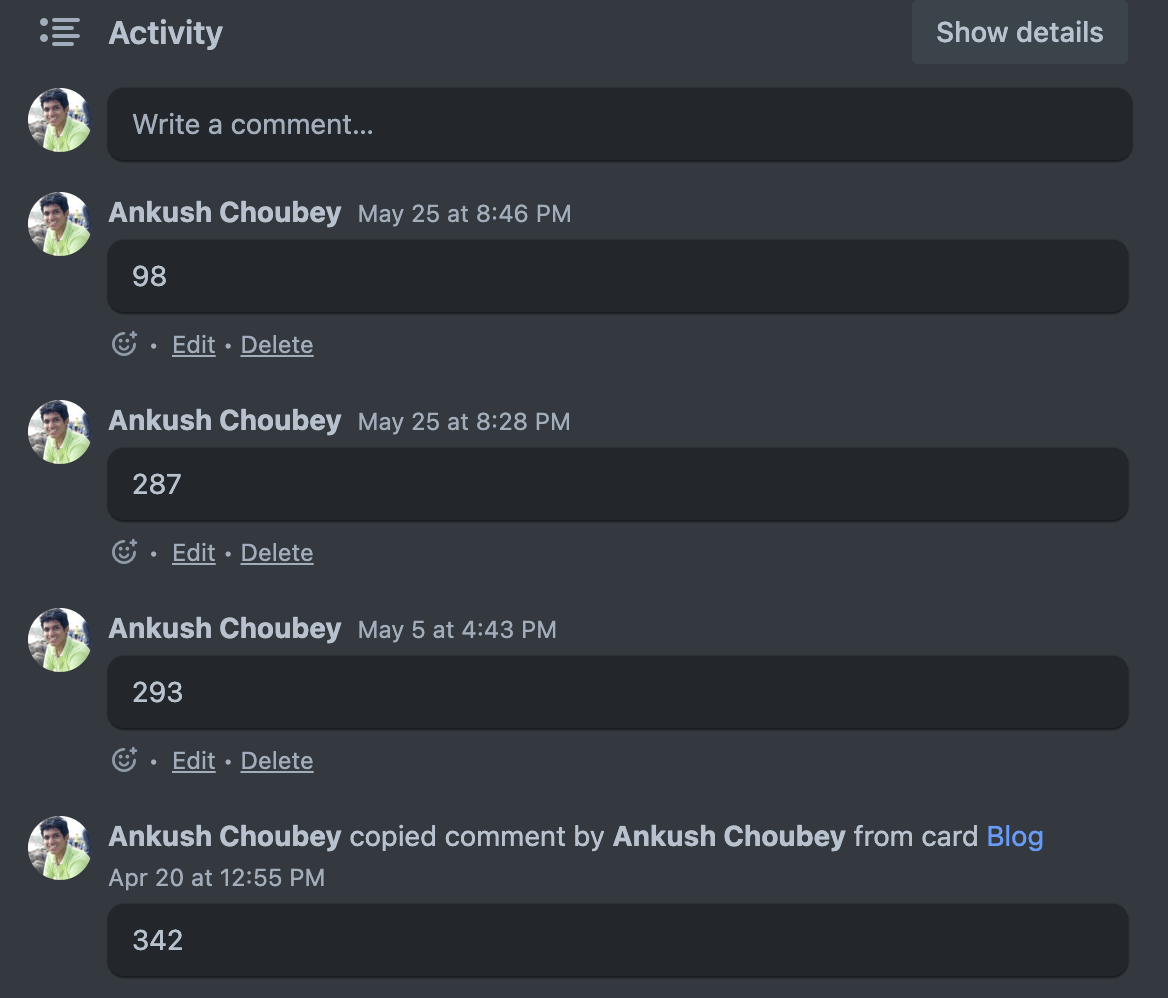
Cards
Cards are equivalent to tasks for Trello.
I use cards to,
- create a checklist for
- making sure the card is created perfectly (S.M.A.R.T. and Small)
- breaking down tasks into 30-minute chunks
- track chained tasks (Tasks that got created because of the current task)
- debrief tasks
- ChatGPT prompts that can help me be better
- comments section for all details, including
- writing notes on things I am learning
- writing drafts of blog posts
- status/progress of the card if it has been on hold for months
- debrief of what went well and what can be improved
- any other informtion
- and have attachments for any information I need for doing the task for future reference, including
- images
- website links
- documents
- procedures
- link to other cards
This way, once I open a card, I know exactly what to do, and I can refer to the card in the future if I need to know how I did something.
Card Structure
Trello allows the creation of templates for cards. I have multiple card templates, but I have been trying to unify them recently. You want to keep the number of templates low, similar and straightforward because they can quickly get overwhelming.
I may have around 1-2 templates per board, with most including the following checklist:
- 🗑️ Categorize this ticket & Delete Me: Assign Labels When Card is Created. I’ll delete this checklist once labels are added.
- 🗑️ Make this SMART/TDD & Delete Me: I’ll use this checklist to work on the task. As part of this, I’ll make this ticket specific, measurable, etc, by breaking it down properly and assigning a due date.
- ☕️ Waiting for: This includes things I am waiting for. It could be dependencies on people or other cards.
- 🚀 Breakdown / Checklist to 30 min tasks: So that I can do it as pomodoros
- 🔗 Chained Tasks: Additional tasks related to this one.
- 📝 Debrief: What went well? What can be improved? How?: Any improvements I need to make?
The top two portions are just for planning and can be deleted.
(The below image was taken before adding ‘☕️ Waiting For’)
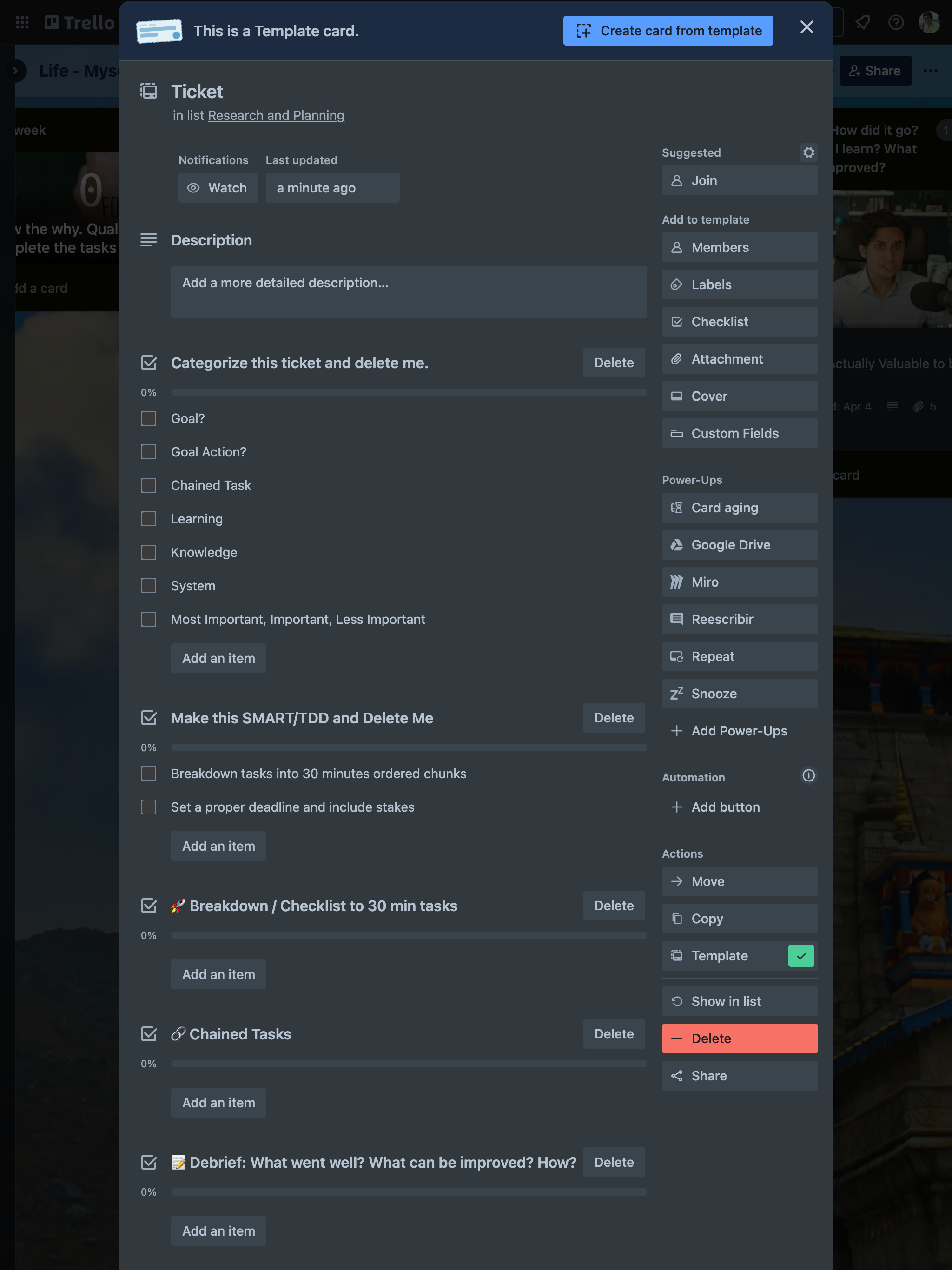
I have also started incorporating ChatGPT Templates into Checklists and other relevant links in my checklists.
Example: Blogpost Template
- Blogpost Template Contains:
- Pre-Writing JotForm
- A ChatGPT Prompt to Help Generate YouTube Shorts from the blogpost
- Post Writing JotForm
Breaking down Big Cards into Smaller Specific Cards
To tackle large tasks effectively, breaking them into smaller, achievable tasks is essential.
Example: Launching a New Website Consider the task of launching a new website. This can be broken down into several specific steps:
- Learning about website launches
- Signing up for a hosting service
- Defining the content
- Writing the content
- Designing the layout
- Testing the website
- Promoting the launch
Benefits of Breaking Down Tasks
By breaking down a big task into smaller steps, you can:
- Improve Clarity: Understand the task better and identify specific actions needed.
- Enhance Manageability: Make the task less overwhelming and more achievable.
- Boost Motivation: Experience a sense of accomplishment as you complete more minor tasks.
How to Break Down Tasks in Trello
In Trello, you can break down tasks in two primary ways:
- Cards: Create individual cards for each sub-task. This is especially useful for tasks that span multiple weeks or months.
- Checklists: Use checklists within cards for more detailed breakdowns. This is ideal for complex tasks that have many smaller components.
Usually, if I have a task that takes multiple months, I’ll break it down into smaller cards that I can take action on in about a week. Recently, I found it hard to break down tasks, so I found a way to break down tasks called Work Breakdown Structure (WBS).
I hope to use this for tasks that are hard.
Steps:
- You create a flow diagram and split each big task into smaller tasks
- Iterate until all tasks are small
- Convert tasks into cards and work on them.
Here’s a fictional example of it: Mermaid Chart Link
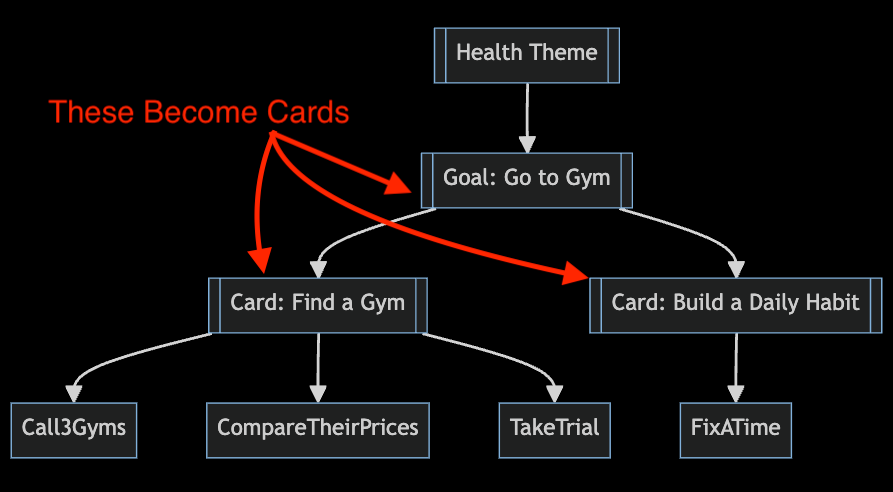
For the checklist, it depends; I may not use the checklist if the task itself is small. But if a task gets complex, I’ll break it down into checklists.
Tips on Creating & Managing Multiple Boards Without Getting Overwhelmed
I realized that more boards make Trello overwhelming. But by not having more boards, I was missing out on productivity gains.
- Good planning
- Ultimately getting progress
I figured out there was no other way; I needed to create more boards.
The way I did it was much more organic. I experimented with a few boards. I also deleted a few; for example, I realized the Job board wasn’t super useful for me because 90% of recruiters ghost and the rest reply super late after a month or two. ⏰ . The cards on my Job Search board would remain stale. So, instead, I started tracking only when I had passed the initial screening and was giving online tests.
Initially, I also mixed writing and all other tasks into one board. This made it very overwhelming. I started by separating Life and Writing. ✍️ Then I realized I needed something for Development, so I created one called DevLife. These remained my main boards.
Later, I realized I needed ways to improve my health, so I started Body Board. Then I thought I should also do things in life. I am someone who doesn’t go out much. I believe It’ll be good to get out. Maybe watch shows, etc., so I created an Experiences board.
The tip is this: anything vital to you should be part of Trello. If it’s small you can keep less number of boards. But as you get more interested, you’ll find splitting into a separate board is better.
Note depending on the domain, the speed at which cards move changes.
For example, travel board tasks will be added over months but will be completed in a week when you go on a trip. Most of the year, you’ll spend time planning your travel.
Similarly, the board will have a lot of goals that will take time.
- Finance Stories usually move faster. Financial goal achievement is slower over months.
Knowing this gives you a satisfaction. You know everything is under control and moving.
How to keep your board interesting to use?
To make your board enjoyable to use:
- Change the background image to something you like.
- Add images to cards, especially goal cards.
- Use dash cards and a Trello power-up to show quick counts of items in lists or based on specific criteria.
- Changing names of columns and boards:
- Keep updating names iteratively to give a new perspective on the board.
Example: My finance board had names like “Money,” “Paisa,” “How money works,” “Finance,” and currently “Finance Flyway”
However, as you get more productive, it’s better to enhance each column by breaking each into multiple columns.
Ending
Even if you don’t use Trello, I hope you found the above insights valuable.
Capture and structure your tasks so that you know what you need to do and why and can progress towards doing it. Create templates that can help you save time. And break down tasks into manageable chunks.
Here’s a recap of the above article:
- Board Structure: Tailor your boards to your needs by enhancing the basic To Do, Doing, and Done columns. Split columns to manage tasks better and use methods like MoSCoW and the Eisenhower Matrix for prioritization.
- For Doing/Done, you can split column into following
- Planning / Making it easy
- Doing Repetitions and Sets
- Chained Tasks if Any
- Freeze if needed
- Debrief: What went well? What did not go well? What can be improved? How?
- Closed / Karma Ledger
- Card Structure: Utilize detailed card templates, breaking down large tasks into smaller, manageable chunks. Use checklists and labels to keep everything organized and ensure nothing is overlooked.
- Dashboard Board: If you have multiple boards, create a Command Center keep track of your weekly goals. Use dashcards to monitor progress and keep your boards clean and efficient.
By continuously refining your system, you’ll find that Trello can adapt to your evolving needs, helping you maintain high productivity and achieve a balanced, organized life. Remember, the key is to keep things simple, scale as needed, and always aim for balance.